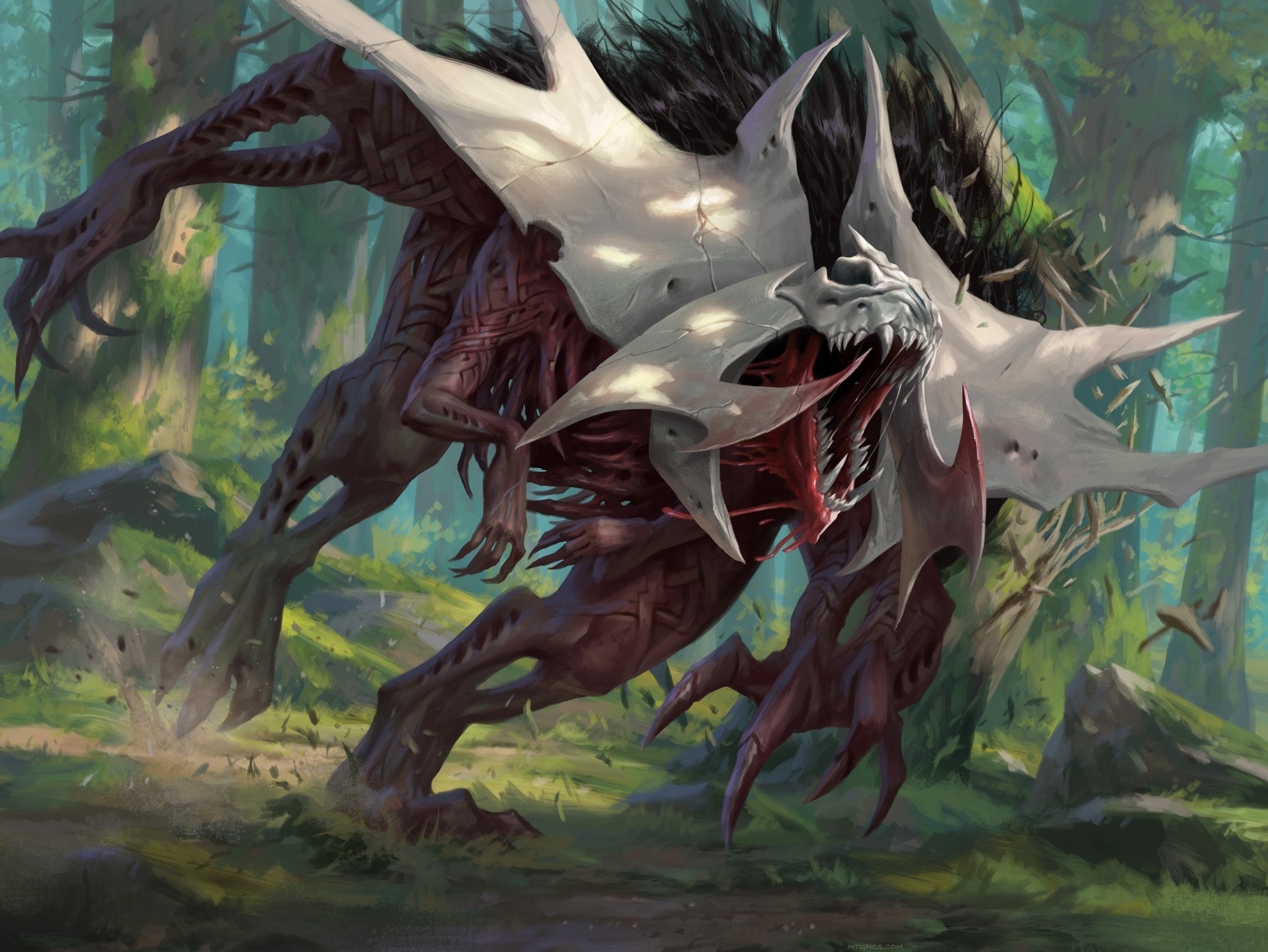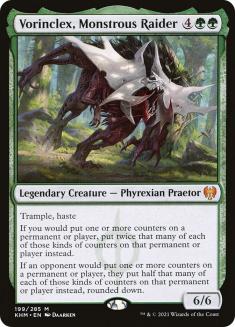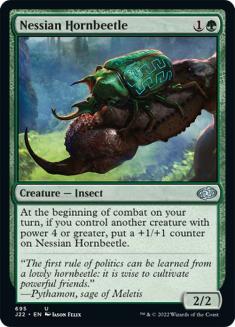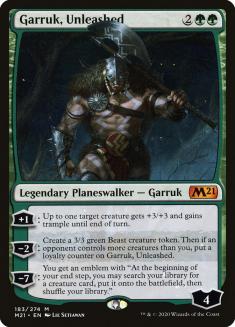It seems like in recent years, the average number of words on a given card has at least tripled. Overall, I like the change, because it means we get a lot of complex cards that have plenty of hard-to-see applications until you actually start slinging the spells, but it certainly makes preview season more daunting. I can see an efficient removal spell or above-rate creature and be confident it will see competitive play, but Sagas with three disparate abilities and utility creatures with 40 lines of text are supremely difficult to evaluate just by reading.
Fortunately, I have the advantage of playing the cards in a semi-competitive setting on VS Live! against a world-class Magic player in Corey Baumeister (please don’t tell him I said that). Over the course of a couple of weeks, we get a first pass at most of the standout cards in the set, and every now and again we see a card come out and really impress. On last week’s show that card was Vorinclex, Monstrous Raider, and since then I’ve been giving the card a lot of thought.
The text box clocks in at 66 words, so there’s a lot to take in. Firstly, it’s a huge top-end threat as a 6/6 with trample and haste. Then you have the Doubling Season-esque ability, a staple in Commander that has seen competitive play in cheaper forms with Hardened Scales and Winding Constrictor. And last, there’s the reverse Doubling Season, certainly the most interesting aspect of the card since it has the least precedent. Let’s consider these three aspects of Vorinclex separately.
Vorinclex the Finisher
It’s the least flashy part of the card, but this one is the most important for determining how it fits into a deck.
Trample, haste
For many years now we’ve seen aggressive decks fill the top of their curve with threats that come down and quickly end the game, even in the face of blockers. When it comes to current Standard, Embercleave is the cream of the crop, but Questing Beast does a good job, too. Vorinclex matches up well here because the body is large enough to rumble with the other big creatures, notably attacking through Lovestruck Beast and at least trading with the likes of Elder Gargaroth and Kogla, the Titan Ape.
Against nongreen decks, Vorinclex should dominate the battlefield and end the game in two attacks or fewer, which is exactly what you’re looking for. That means you’ll demand an immediate answer from your opponent. Combined with the fact that you’ll often get a profitable attack by virtue of haste, and Vorinclex will nearly always leave you ahead when exchanging with removal or in combat. And if Vorinclex goes unanswered, you should be leaving with the win.
So it’s clear that you want to play Vorinclex as the curve-topper in an aggro deck. The one issue here is costing six mana. That’s higher than usual for an aggro deck, where you’d ideally want to end the curve at four or five. So I’m interested in pairing it with the full four copies of Castle Garenbrig, letting you cast it ahead of schedule and keeping a smooth curve. That means heavy green so your Forest count is high, likely monocolored.
Vorinclex the Counter Disabler
We’re tackling the last two abilities of Vorinclex out of order, but this is the one I think is more important and what led to it being so impressive on VS Live! recently. The key here is that you round down after halving, so anything that places one counter on a permanent or player now places zero.
If an opponent would put one or more counters on a permanent or player, put half that many of each of those kinds of counters on that permanent or player instead, rounded down.
There are plenty of sources of +1/+1 counters that Vorinclex can shut down, from Luminarch Aspirant to Scavenging Ooze to Wicked Wolf, and blunting those cards is a nice ancillary benefit, but Vorinclex really shines when your opponent is playing Sagas. The triggers from each chapter are dependent on adding a lore counter, so Vorinclex simply stops them from progressing. And Sagas cast while Vorinclex is on the battlefield won’t have any effect until the Praetor is removed.
When it comes to answering expensive threats in Standard, two of the most common cards you find players reaching for are Elspeth Conquers Death and The Akroan War. Dimir Rogues has Heartless Act and Drown in the Loch but those come with other conditions that you can play around. Standard decks will be taken by surprise when their key reply to your mid-game threat no longer works, and even if they adapt, that means moving away from some of the most powerful cards in the format.
Even with a mix of Heartless Act and Sagas, if you play Vorinclex in an aggressive shell, you can easily draw out the cheap removal spells with a strong start. No one can afford to leave a Kazandu Mammoth or Lovestruck Beast unchecked for multiple turns to hold on to an answer to Vorinclex, especially when those creatures enable an early The Great Henge. Green doesn’t get a lot of creatures with this kind of disruptive capability, and that’s why I’m excited for it in Kaldheim Standard.
Vorinclex the Counter Enabler
I mentioned several +1/+1 counter synergies that Vorinclex will shut down for your opponent, and conversely that means there are plenty of ways to leverage the first replacement effect.
If you would put one or more counters on a permanent or player, put twice that many of each of those kinds of counters on that permanent or player instead.
However, Vorinclex doesn’t fit well as a build-around in this aspect because of its mana cost. By the time you cast it, you’ve already cast most of the cards it would affect, leading to this ability doing very little or overkilling your opponent by a lot.
Cards like Hardened Scales and Winding Constrictor work because they come down first and bolster each successive play, so they are cheap threats that demand an answer or they snowball out of control. Vorinclex is so large and potentially disruptive that it already demands an answer. In a lot of games, you won’t need to follow it up with anything.
But that doesn’t mean this ability is irrelevant. As an aggro finisher, I’m inclined to lean into this ability with flex spots, playing cards like Nessian Hornbeetle that it synergizes with when I otherwise wouldn’t. Yorvo, Lord of Garenbrig would be another consideration, but the three-slot for green is glutted and I’m not willing to eschew staple cards like Lovestruck Beast and Kazandu Mammoth to further any counter synergies.
In a more dedicated counters deck, Vorinclex can’t serve as the central build-around card, but as a powerful card in its own right, it slots in as a secondary build-around to Conclave Mentor. In that role it can either be a finisher or a way to go way over the top of your opponent when the battlefield clutters and a 6/6 isn’t enough to break through.
With this understanding, let’s look at the two best homes for Vorinclex in Kaldheim Standard, starting with Mono-Green Aggro:
Creatures (30)
- 4 Scavenging Ooze
- 4 Lovestruck Beast
- 3 Questing Beast
- 4 Stonecoil Serpent
- 4 Nessian Hornbeetle
- 4 Gemrazer
- 4 Kazandu Mammoth
- 3 Vorinclex, Monstrous Raider
Planeswalkers (2)
Lands (21)
Spells (7)

This is a pretty straightforward Mono-Green Aggro list with a few alterations to fit Vorinclex into the deck and maximize its abilities. First is to move Vivien, Monsters’ Advocate entirely to the sideboard. One of the issues Mono-Green Aggro had last season was an inability to punch through to finish the game. Vivien is a great top-end against reactive decks, but in creature mirrors it’s tough to land safely and often leads to a cluttered battlefield rather than a decisive advantage before your opponent finds some way to remove it. Vorinclex can provide that punch and, with Castle Garenbrig, occupies the same spot in the curve.
Second is the addition of Nessian Hornbeetle. With a powerful finisher in the deck, I want to lower the curve as much as possible to ensure a strong start, and Hornbeetle is the next best two-drop after Scavenging Ooze. The synergy with Vorinclex is nice but it’s more important for you to have three-drops that can start triggering it immediately, which we do with Lovestruck Beast and Gemrazer. This list won’t contend in the long game with most decks, so you need to get ahead early. Hornbeetle is great in that role.
Last is the inclusion of Garruk, Unleashed in the maindeck. I’m higher on this card than most, and it contributes to the more aggressive bent this list takes, but it also synergizes nicely with Vorinclex. Garruk will enter the battlefield with double loyalty, allowing it to ultimate immediately and stick around for more, so you have something other than The Great Henge to go to should you need to break through a cluttered battlefield.
I barely tried to build around the counter-enabling ability of Vorinclex in this list and still ended with seventeen cards that utilize counters in some capacity, an excellent number. I expect a resurgence in this deck in the early days of Kaldheim Standard because Vorinclex makes it significantly better at closing the game and harder to prepare for.
The second home for Vorinclex is Selesnya Counters:
Creatures (32)
- 4 Stonecoil Serpent
- 3 Gemrazer
- 4 Basri's Lieutenant
- 4 Conclave Mentor
- 4 Wildwood Scourge
- 4 Swarm Shambler
- 4 Luminarch Aspirant
- 2 Oran-Rief Ooze
- 3 Vorinclex, Monstrous Raider
Lands (20)
Spells (8)

This list plays a lower curve than Mono-Green, utilizing the counter synergies to compensate for its creatures’ lesser starting stats. That lower curve also allows it to fit two copies of Snakeskin Veil as a great way to protect your most valuable threat, whether that’s a Conclave Mentor or some creature you’ve put a ton of resources into growing.
Consider the following curve:
- Turn 1: Swarm Shambler.
- Turn 2: Luminarch Aspirant, pump the Shambler, attack for two.
- Turn 3: Conclave Mentor, pump the Aspirant, attack for three.
With a third land drop, you can protect this position with Snakeskin Veil while also representing a Swarm Shambler activation to add two counters and make it a 4/4. That’s a great opening sequence that will trade effectively against a lot of removal because of Swarm Shambler’s ability, even without protection. Basri’s Lieutenant provides further protection for your growing army of creatures, and of course Vorinclex sits atop the curve ready to slam the door shut when your opponent is on the verge of stabilizing.
The sacrifice you make is in the consistency of the mana. Mana for two-color aggro decks is always a struggle, and early Fabled Passages will muck up the works more often than I’d like. You do get access to Emeria’s Call for more staying power, but you have to cut down to two copies of Castle Garenbrig since there are fewer Forests. The flexibility of Stonecoil Serpent and Wildwood Scourge helps fill your curve when you have an awkward tapped land, but ultimately the increased power from the counter synergies will cost you some consistency.
Vorniclex the Unbeatable?
I expect Vorinclex, Monstrous Raider to end a lot of games in Standard over the next three months, and it’ll reshape how players tune their removal packages once they spend a weekend or two staring at a hand of irrelevant Sagas. I think it has a ceiling that rivals Embercleave in leaving people feeling helpless, but because it’s a standalone threat it has a higher floor. That could lead to more diversity among aggressive decks, since Gruul Adventures’s grip on that portion of the metagame is largely predicated on the power of that Equipment.
Standard has been remarkably healthy since the Omnath ban, but quite stale for the last month. Vorinclex is poised to disrupt the current state of things and get the metagame churning again.





